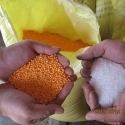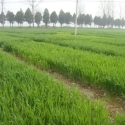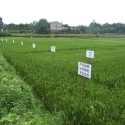Effects of nitrogen nutrition on oxalate accumulation in different spinach genotypes and corresponding mechanisms

Spinach (Spinacia oleracea L.) is one of the most popular leafy vegetables, which is widely cultivated and commonly consumed in diets. Recent research indicates that spinach offers better nourishment than most cultivated vegetables, as it contains many biologically active compounds, e.g. vitamins, folic acid, flavonoids, mineral components and dietary fibre. However, spinach also contains large amounts of oxalate which is considered to be an antinutrient and a toxin for human health. Upon consumption, oxalate can have negative and corrosive effects on internal tissues in humans. Meanwhile, its precipitation with calcium can reduce the nutrient’s bioavailability and enhance the possibility of forming kidney stones. It is therefore important to search for effective strategies to reduce oxalate contents in spinach. Oxalate content differs among genotypes within a given species for many vegetable crops, while the menchanisms involved in genotypic difference of oxalate in spinach is still far from understand. Nitrogen nutrition is one of the most important factors affecting biomass production and oxalate accumulation in plants, whereas little is known about the mechanisms involved in the association of N with oxalate accumulation in spinach. In the present research, two spinach genotypes differing in oxalate accumulation were employed to investigate the genotypic difference of oxalate accumulation in spinachs suppied by different N levels and forms. Furthermore, the possible relationships of N uptake and metabolism with oxalate metabolism in the two genotypes of spinach were also investigated by using N uptake kinetics, precursors of oxalate biosynthesis, as well as inhibitors of N uptake and reduction. The aims of this study are to elucidate the mechanisms of oxalate metabolism in spinach and its association with N, as to provide scientific basis for producing nutritional and low oxalate-accumulating spinach by using the combined measures of genetic breeding and nutrient management.
The results showed that:
1) Ammonium reduces oxalate accumulation in different spinach genotypes by inhibiting root uptake of nitrate. Nitrate exposure significantly induced oxalate accumulation in vegetables while mixed nitrate and ammonium exposure usually have the negative effects. Two spinach genotypes (HZZ and WL), which differ in oxalate accumulation were employed in absorption kinetics experiment to investigate whether genetic variations of blade oxalate accumulation in spinach are correlated with their ability to uptake nitrate and ammonium by roots. Dose-dependent increase of blade oxalate contents and root nitrate uptake rate were observed in both spinach genotypes after exposure to elevated nitrate levels. In contrast, increasing ammonium did not result in elevation of blade oxalate in the both spinach genotypes. Correlation analysis confirmed that blade oxalate accumulation was positively associated with root uptake of nitrate but not ammonium. Treatments of mixed nitrate and ammonium (1:1) solution caused a decrease of oxalate accumulation in the both genotypes when compared with those treated with equal nitrate levels. Meanwhile, the value of Vmax for nitrate in mixed N solution decreased significantly when compared with sole nitrate, but the two treatments exhibited similar Km values. When exogenous ammonium (1.0 mM) added to nitrate solution, both oxalate content and nitrate uptake was inhibited compared with that grown in nitrate alone. When compared with the controls, the values of Vmax for nitrate were reduced by 55.36% and 67.15% with addition of ammonium for HZZ and WL, respectively, whereas no significant change of Km values was observed. High-oxalate accumulated cultivar HZZ had a higher nitrate uptake rate compared with the low oxalate accumulated cultivar WL when supply nitrate or mixed N solution. The results suggest that oxalate synthesis in spinach blades is associated with its root uptake of nitrate, and ammonium is able to reduce oxalate accumulation by inhibiting uptake of nitrate. Genotypic difference in oxalate accumulation is primarily relate to root nitrate uptake rate.
2) Oxalate synthesis in leaves is associated with root uptake of nitrate and its assimilation in spinach plants. Our previous studies showed that oxalate accumulation in leaves of spinach was closely associated with root uptake of nitrate. However, the mechanisms involved in the association of oxalate accumulation and nitrate assimilation within the plants of spinach remains unknown. In the present study, we investigated the possible association of nitrate assimilation in spinach plants with its leaf accumulation of oxalate by using two different genotypes with the aim of better understanding the mechanisms of oxalate synthesis in spinach plants. Increasing nitrate levels resulted in enhanced synthesis of oxalate, as well as increased root uptake of nitrate and leaf activities of nitrate reductase (NR) and glutamine synthetase (GS) for both genotypes. High-oxalate accumulating genotype HZZ showed a much greater enhanced root uptake rate of nitrate, leaf NR and GS activities as compared with WL, which is a low-oxalate accumulated genotype. Correlation analysis revealed that oxalate accumulation in spinach leaves was positively related with rate of nitrate uptake by roots, as well as leaf activities of NR and GS. Addition of plasmalemma H+-ATPase-inhibitor sodium vanadate (Na3VO4) significantly decreased leaf oxalate accumulation in both genotypes. Presence of NR or GS inhibitors led to reduction of leaf oxalate contents, GS/NR activities, and decreased nitrate uptake rate. Significantly higher levels of nitrate root uptake, leaf NR and GS activities were observed in HZZ than in WL. Total and soluble oxalate accumulation increased markedly in leaves of both genotypes as the solution pH changed from 6.0 to 8.0 regardless of the nitrate application. In contrast, there is no significant effect of solution pH on NR activities in leaves of either genotype. This study provides clear evidence that oxalate accumulation in spinach is positively associated with both root uptake of nitrate, nitrate reduction and its assimilation within the plants. The description of oxalate accumulation between different spinach genotypes may be cause by nitrate uptake, reduction and assimilation.




